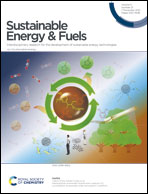Nano-zirconia boosting the ionic conductivity and lithium dendrite inhibition ability of a poly(1,3-dioxolane) solid electrolyte for high-voltage solid-state lithium batteries†
Abstract
A high ionic conductivity, excellent mechanical and strong inhibition ability of lithium dendrites are necessary for polymer solid electrolytes. In this work, a poly(1,3-dioxolane)/yttria-stabilized zirconia (PDOL–YSZ) composite solid electrolyte membrane (CSEM) was prepared for the first time by using lithium hexafluorophosphate (LiPF6) to initiate 1,3-dioxolane (DOL) polymerization. YSZ nanoparticles promote the polymerization process of DOL and more free Li+ ions are released through its reaction with the anions of the lithium salt, resulting in a high ionic conductivity of 5.82 × 10−4 S cm−1 and a wide electrochemical stability window of 5.1 V. Besides, YSZ can react with the lithium anode to form a stable solid electrolyte interface (SEI) including a Li2ZrO3 fast ionic conductor, which is beneficial to the interface stability between the lithium anode and the CSEM, inhibiting the growth of lithium dendrites during battery cycling, and the Li/CSEM/Li cells can be cycled stably for nearly 1500 hours at a current density of 0.1, 0.3 and 0.5 mA cm−2. The assembled LiCoO2/CSEM/Li cells can be cycled for 200 cycles at 0.5C with a capacity retention of 90%. This PDOL–YSZ CSEM shows high promising commercial application prospects due to its easy preparation, high ionic conductivity and excellent inhibition ability of lithium dendrites.



 Please wait while we load your content...
Please wait while we load your content...